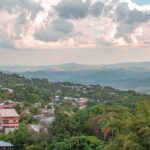Throughout history, people thought that economic gain and environmental protection stood in conflict with one another. The two were seen as opposing players in a zero-sum game–one could not advance without hurting the other. But today, many recognize that the economy and the environment need one another to continue thriving. And both are critical to solving global problems like land degradation, climate change and poverty.
During a recent conference on ecosystem services presented by the American University of Armenia’s (AUA) Acopian Center for the Environment, 1000 Landscapes for 1 Billion People (1000L) Chair Sara Scherr discussed one of the most robust solutions to address global issues: integrated land management (ILM). The approach combines natural resource management with environmental and economic considerations to optimize the outputs of all three.
Scherr spoke to an audience that included Armenian government officials, which offered the opportunity for productive discussions surrounding policy implementation and land management in Armenia. The conference comes at a pivotal time for the country, which sits in the Caucasus region straddling Europe and Asia.
According to Deputy Minister of the Economy Arman Khojoyan, the government is developing several land-reform projects and changing policies. “We are at the moment of deciding which direction we go,” Khojoyan said.
The major issues affecting Armenian landscapes are land fragmentation and low soil productivity. To remedy these problems, Khojoyan revealed the government is looking into creating a centralized land agency, which will act as a mediator between farmers and investors. He also shared that the Armenian government is investigating ways to better communicate with farmers about the important role biodiversity plays in increasing agricultural yield and productivity.
Though the discussion focused on how to make Armenia’s land management more inclusive and sustainable, the session offered universal pathways for any locality to reimagine how it manages its land.
ILM, the solution to a timely debate
In her talk, Scherr discussed how present realities no longer allow policymakers to choose between agricultural productivity and increased biodiversity. “Policy is no longer about trade-offs,” she said. “We cannot choose [between agriculture and the environment] because we will get neither. Production systems and landscapes need to produce both food and ecosystem services. We realize now that fragmented responses will not work.”
So, if land managers can’t choose between one aspect and another, what should they do? Scherr said that inclusive approaches like ILM provide the most potent answers. ILM “is a mechanism through long-term collaboration among land managers and stakeholders to realize multiple objectives from the landscape,” she said.
This approach is effective because it engages every level of stakeholder in and around a landscape, which creates a management strategy that achieves productivity, environmental and livelihood goals. The integrated part of ILM is crucial, as results using this solution will benefit all stakeholders involved, she said. In a polarized world filled with competing interests and goals, ILM offers a new perspective where compromise and shared experiences become the foundation for land development and use.
ILM encourages stakeholders to step outside of what they know when examining their landscape and community. Scherr said she hopes that 1000L will be a global catalyst for this kind of creative thinking.
1000 Landscapes—the missing piece
After her presentation, the conference session moved into an engaging questions and answers period followed by a panel discussion. Throughout the second half of this session, Scherr fielded questions about how to implement ILM, which she answered by stressing the need for 1000L.
Several audience members asked how to overcome the specific challenges they faced in their efforts to restore and manage lands. One questioner wanted to know about solutions that foster both forest restoration and community development. In response, Scherr highlighted an integral piece of 1000L, the in-development Global Action Network (GAN).
The GAN “will enhance knowledge-sharing among landscape partnership leaders online and through in-person dialogue, build alliances to inform policy and link partnerships more effectively with businesses, government, funders, researchers and expert technical services,” she said.
The network will offer the opportunity for communities and landscape partners to share solutions, common problems and successes. Additionally, the GAN will provide participants with a direct way to build partnerships with many potential stakeholders.
“There isn’t anyone in the world who has solutions to all of this,” Scherr said. “It is a transformational direction for most countries in the world to shift from a pattern of degradation to one where we’re actually reestablishing thriving agriculture [and] inclusive businesses.”
As the world seeks holistic solutions that boost agriculture, biodiversity and livelihoods, 1000L will be an excellent resource for all those carrying out sustainable development projects globally, she said.
The biggest risk
This first session of the AUA Conference offered many insights into the practice and benefits of ILM. It will be interesting to see how Armenia employs this approach in its land-planning and management.
Like many nations and regions searching for ways to transform their landscapes into areas that better serve people and biodiversity, Armenia will face many challenges to implementing ILM, from decentralizing government roles to countering citizens’ lack of understanding of the value of ecosystem services. But panelist Khojoyan left the session with an impactful final point.
Quoting Dubai’s Minister of Climate and the Environment, Mariam Almheiri, Khojoyan said, “The biggest risk is to not take the challenge.” The world can no longer afford to use piecemeal solutions that only respond to one interest or goal. Holistic approaches like ILM show that meaningful large-scale change is possible.
Scherr agreed, saying that the most difficult step is the first one. To that end, she is optimistic about all of the conversations and labor going on worldwide. “One of the things that’s really positive about the work that I do is that I get to talk to people from all over the world who are being creative with their solutions,” she said.
See Scherr’s full talk below. To watch other conference sessions click here.
Top photo by Ani Adigyozalyan on Unsplash.


